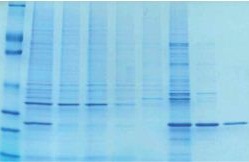Question:
Recombinant Proteins: How Are They Made?
The Protein Man Says:
 Recombinant proteins are widely used in the fields of medicine and biotechnology research. You may not be aware of it but recombinant proteins are extensively being used in pharmaceutical and medical testing laboratories, doctors' and veterinarians' offices and biological research laboratories, to name a few. Practical applications of this technology are also found in the fields of agriculture, food processing, industry and bioengineering.With the extensive application of this technology, are you starting to wonder how recombinant proteins are made?
Recombinant proteins are widely used in the fields of medicine and biotechnology research. You may not be aware of it but recombinant proteins are extensively being used in pharmaceutical and medical testing laboratories, doctors' and veterinarians' offices and biological research laboratories, to name a few. Practical applications of this technology are also found in the fields of agriculture, food processing, industry and bioengineering.With the extensive application of this technology, are you starting to wonder how recombinant proteins are made?
Recombinant Proteins – How Are They Made?
The most common method by which recombinant proteins are mass produced for laboratory and industrial purposes is called molecular cloning. There are three basic requirementsincreating recombinant proteins - the coding sequence for the heterologous protein, the cloning vector (usually a plasmid or virus) into which the protein of interest will be cloned and a suitable host (can be a bacteria, yeast, insect or mammalian cell) that will express the protein of interest.
The cloning process. Recombinant proteins are mass produced following these steps.
- Choosing an appropriate cloning vector.This depends on the size of the DNA to be cloned, the nature of the host organism and the way by which the foreign DNA is to be expressed.
- Choosing a host or expression system. The choice of host will depend on the size, complexity and glycosylation of the protein of interest, the resulting amount of recombinant protein needed, the demand for authenticity and your budget. For human proteins, mammalian host cells work best but this is undoubtedly the slowest and the most expensive option. In addition, mammalian cells are quite sensitive to external conditions and are not designed to survive outside the body. Given these limitations, you may want to use insect cells instead since they have all the advantages of mammalian expression systems but are easier and cheaper to use. You can also use E.colisince it isthe cheapest, fastest and easiest option but you need to remember that it doesn't work with all proteins.
So, what happens after you have successfully chosen your vector and host? We'll be discussing the remaining steps involved in creating recombinant proteins and a lot more on our next blog so watch out for it.






